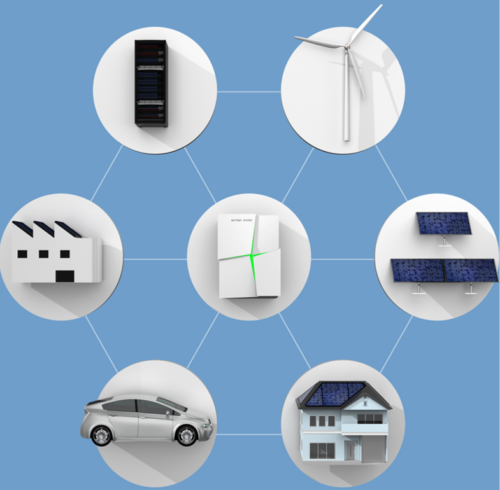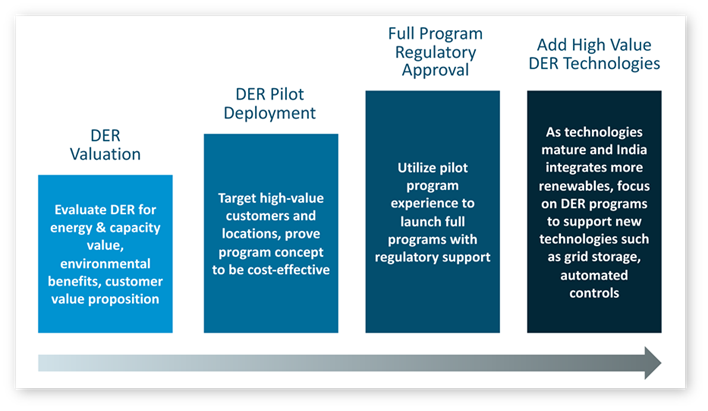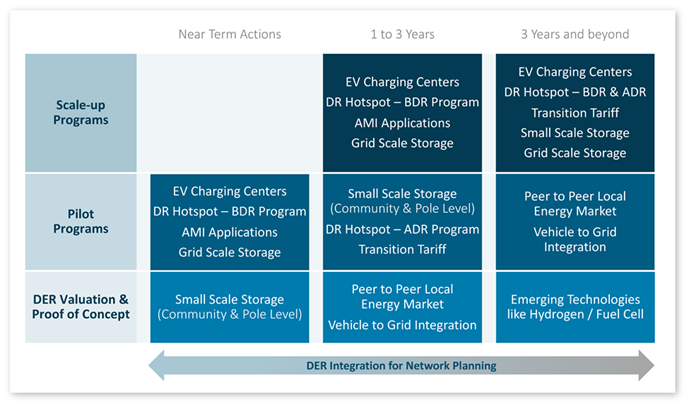
In India, rapid renewable deployment, rising electricity demand due to growing economy, and generation capacity overbuild have created both challenges and opportunities for distribution companies. Distributed Energy Resource (DER) technologies can enable distribution companies in India to adapt to the changing national economy and electricity grid, providing benefits for customers and utilities alike while helping India achieve long-term climate and environmental goals.
With a United States Trade and Development Agency (USTDA) grant titled “Regulatory and Business Cases for Distributed Energy Resources in India: Phase 2,” E3 supported Tata Power-DDL as it explored the regulatory and business cases for a broader set of DERs including electric vehicles, demand response, storage, and energy efficiency in India.
Over a five-year period, E3 supported Tata Power-DDL, an Indian electric utility serving 7 million customers in Delhi, in the development of a distributed energy resources roadmap and valuation framework. E3 provided input to help guide proposals to move forward with near term DER programs, including a Demand Response Hot Spot Program (DR Hotspot) focusing on load reduction in local constrained areas, and an EV Charging Infrastructure Program focused on closing the gaps in deployed EV charging at Tata Power-DDL. Beyond these two programs, a Distributed Energy Transition Roadmap was put in place to guide the development and deployment of future DER program designs – technologies with near-term viability are to be deployed through pilot programs, while nascent technologies are further researched until program implementation is deemed ready. E3 then integrated the benefit-cost analysis framework and associated tool, which E3 developed to support this decision-making, into the RESTORE and IDSM models to be used to guide DER strategy in the future for utilities and policy makers.
E3’s support began with analyzing Tata Power-DDL’s system to understand 1) the cost-effectiveness of DER technologies from different perspectives in the benefit-cost analysis framework, 2) the optimal DER portfolio that maximizes the benefits for the entire system, and 3) the pathway to realize the optimal portfolio through proper incentive structures or other mechanisms. Based on the system overlook, E3 then supported Tata Power-DDL in evaluating, accessing, screening, and prioritizing DER pilot programs under the benefit-cost evaluation framework using RESTORE, E3’s DER smart dispatch tool. Based on E3’s analysis, Tata Power-DDL decided to focus on a subset of DER programs and identified two DER pilots for the beginning of a distributed energy transition roadmap: EV charging centers and the DR Hotspot Program. For the EV and DR pilot programs, E3 also provided regulatory support to Tata Power-DDL in developing information to facilitate conversations on these new DER programs with their regulator, Delhi Electricity Regulatory Commission (DERC).
The initial seven pilot programs include the following:
- Electric vehicle infrastructure and charging rate, all types
- Distribution ‘hot spot’ demand response rate
- Grid-connected (utility controlled) energy storage systems
- A/C temperature set-back, health and comfort program
- Technology leader’s energy transition rate
- Volt-var optimization


The final study (without appendices) is available now on the E3 website. The full report, including appendices, can be obtained by requested from the USTDA library. An E3 team of Snuller Price, Lakshmi Alagappan, Roderick Go, Jun Zhang, Vivian Li, Saamrat Kasina, and Vivan Malkani, along with E3 alums Jasmine Ouyang, Patrick O’Neill, Oliver Garnett, and Huai Jiang, conducted the study with expert support from Brian Horii and Eric Cutter.


